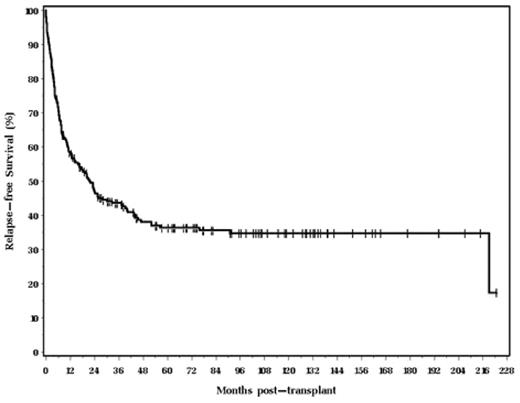Abstract
Patients who undergo high-dose chemotherapy with autologous stem cell transplantation (ASCT) for Hodgkin lymphoma routinely undergo surveillance for post-transplant recurrence. Follow-up schedules after ASCT are based largely upon expert opinion rather than data. To formally describe the evolution of recurrence risk over time for Hodgkin lymphoma after ASCT, we used a prospectively maintained database to retrospectively evaluate the outcomes of 245 patients who underwent ASCT for Hodgkin lymphoma at the Cleveland Clinic Foundation from 1985 through 2005. Patient characteristics: male gender in 64%; median age, 34 years (range, 18–70); median time from diagnosis to transplant, 22 months (4–327); Karnofsky score > 80 in 89%; median 2 prior regimens (1–4); prior XRT in 52%; bulky disease > 10 cm in 20%; stage III-IV in 62%; disease status of CR1/PR1 in 8%, CR2/PR2 in 69%, refractory in 11%, other in 12%; preparative regimen of BuCyVP in 65%, CBV in 26%, TBI/others in 9%. Median follow-up after ASCT for all pts was 35 months (0–223); for surviving pts, 74 months (3–223). At 5 years, estimated overall survival and relapse-free survival were 47% and 36%, respectively. Relapse occurred in 115 pts, with 5-year relapse rate estimated at 44% (Figure).
Landmark analyses were conducted to estimate long-term outcomes for patients in remission at various times after ASCT, as shown in the Table:
| Duration of Remission after ASCT . | Long-Term Likelihood of Continued Remission . |
|---|---|
| 1 year | 63.8% |
| 2 years | 78,8% |
| 3 years | 83.0% |
| 5 years | 97.0% |
| Duration of Remission after ASCT . | Long-Term Likelihood of Continued Remission . |
|---|---|
| 1 year | 63.8% |
| 2 years | 78,8% |
| 3 years | 83.0% |
| 5 years | 97.0% |
These data illustrate the declining threat of relapse that faces patients who achieve remission following ASCT for Hodgkin lymphoma. Most patients who are destined to experience disease recurrence after ASCT do so within the first 2 years post-transplant. Patients who remain in remission 5 years after ASCT are at extremely low risk for subsequent relapse and can be reassured that they are likely cured. This analysis provides a factual basis to support gradually decreasing the frequency of surveillance visits and to discontinue routine monitoring for relapse at 5 years after ASCT.
Author notes
Disclosure: No relevant conflicts of interest to declare.


This feature is available to Subscribers Only
Sign In or Create an Account Close Modal